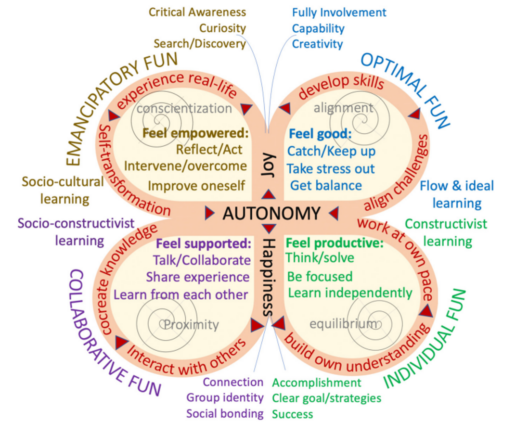Having Fun in Online Classes
In a recent online course I took, I was intrigued by a page in our introductory module called “Break times.” The instructor, Bonnie Chapman explains, “At the end of each module, I include a PowerPoint with humorous items,” going on to say, “This is not a required portion of the course…. It is just a means of me sharing some humor with you. In my face to face [sic] classes, we laugh a lot and that is a dimension in online learning that I feel often is lacking” (Chapman, 2023). Along with the break times, the course has a “meme blitz” assignment, uses Slack for team communication, and provides multiple opportunities for students to choose assignment topics based on their personal, professional, or academic interests.
After finding myself having a lot of fun in the course and connecting more with my peers than I ever have in an online course, I wondered how we might infuse our digital classrooms not just with “fun,” but with the type of joy that comes from authentic learning experiences. In this article, I’ll:
Break down the “Butterfly of Fun” theory,
Highlight the benefits of having fun in online courses, and
Provide practical tips to start implementing fun in your digital classroom.
Where's the Laughter?
When is the last time an online academic discussion made you laugh? When is the last time we encouraged students to share memes or laugh at our own, outdated references? When is the last time that students in an online course shared a sincere moment of connection?
We often warn against attempts to simply replicate in-person courses in digital spaces. The contexts, tools, and connections are different, so faculty, instructional designers, and educational technologists have developed theories and frameworks for the affordances of online learning, but the idea of “fun” often seems to be missing.
The "Butterfly of Fun" Theory
With all the constraints of an asynchronous, 7.5-week online course, how can we start to inject some fun into our classrooms? Okada and Sheehy (2020) conducted a mixed-method study with 551 participants completing a self-reflective questionnaire, and 206 of those participants responding to optional, open-ended questions. They found four types of fun in online learning:
- Optimal fun: “the joy of being fully involved in learning, moving toward full capability and creativity” (Okada & Sheehy, 2020, p. 6). They matched optimal fun with the theories of flow and ideal learning which helps students feel good by developing skills and aligning challenges that empower students to catch or keep up, decrease stress, and get balance (Okada & Sheehy, 2020, p. 6).
- Individual fun: “the happiness of fulfilling accomplishments, supported by clear goals and strategies” (Okada & Sheehy, 2020, p. 6). Individual fun is supported by the constructivist theory of learning which helps students feel productive by working at their own pace and building their own understanding through thinking and solving problems, being focused, and learning independently (Okada & Sheehy, 2020, p. 6).
- Collaborative fun: “the happiness of making connections with others, creating social bonding and developing group identity” (Okada & Sheehy, 2020, p. 6). Leaning into the social constructivist theory, collaborative fun helps learners feel supported as they interact with others and co-create knowledge by talking, sharing experiences, and learning from each other (Okada & Sheehy, 2020, p. 6).
- Emancipatory fun: “the joy of being curious, able to search and discover whilst being critically aware” (Okada & Sheehy, 2020, p. 6). Building upon socio-cultural learning theories, emancipatory fun helps learners feel empowered as they experience real-life learning applications that help them transform through reflecting, overcoming, and improving themselves (Okada & Sheehy, 2020, p. 6).
Creating a Classroom of Fun
With the loss of learning (Bryant et al., 2023) and broken social connections (Xiong et al., 2020) from COVID-19, there may have never been a more important time to start having some fun in our online classrooms, not only for the learning benefits for students but also for the mental and social benefits for burnt-out students and faculty. So, what are some ways to have fun in an online classroom?
- It starts with you, the faculty! As the classroom leader, acknowledge the need for moments of joy in online learning, look for opportunities to infuse your course with joy, and then lead by example. How might you infuse your lecture videos or course announcements with a bit of fun?
- Identify opportunities to increase student choice and collaboration. You can’t just throw some memes in a Slack channel and call it “fun” if the rest of the course doesn’t try to infuse joy into learning (Meilleur, 2021). Providing space for students to pick assignment topics, discussion prompts, and ways to apply their learning to their personal or professional life creates opportunities for creativity, transfer of learning, and higher engagement.
- Create a space just for fun. If you want students to engage in laid-back social exchanges, they need a dedicated space to do so. Slack is one way to accomplish this while also exposing students to the type of communication tool they will likely see in their current or future workplace. Try a weekly, low-point, or optional “meme blitz” to get people sharing and laughing.
- Create time for fun. It can often feel like there’s little time for anything other than rigorous academic exercises in fast-paced online courses, but how might you infuse fun into academic assignments? Remember that fun isn’t always about “being silly”, but rather providing opportunities to create joyful learning experiences that foster student autonomy and authenticity through creative assignments that prioritize student choice and real-world experiences (Ahuja & Nguyen, 2021). How might you create more opportunities for student-student interaction that builds social presence while also conducting formative assessment through peer review?
Having fun is healing, and infusing moments of joy into your curriculum increases “attention, retention and connection” (Ahuja & Nguyen, 2021). Adopting a socio-constructivist approach to course assignments also increases student engagement and empowers them to transfer their learning beyond your course. Plus, who doesn’t like to laugh?
Resources
- Learn about flow theory in education
- Learn about the constructivist theory of learning and the social constructivist theory of learning
- Learn about socio-cultural theory
References
Ahuja, A., & Nguyen, T. (2021, March 15). Get serious about humour in your online classroom. Times Higher Education. https://www.timeshighereducation.com/campus/get-serious-about-humour-your-online-classroom
Bryant, J., Dorn, E., Pollack, L., & Sarakatsannis, J. (2023, January 11). COVID-19 learning delay and recovery: Where do US states stand? McKinsey & Company. https://www.mckinsey.com/industries/education/our-insights/covid-19-learning-delay-and-recovery-where-do-us-states-stand
Chapman, B. (2023). Break Times. TWC 301 Canvas Course. https://canvas.asu.edu/login
Meilleur, C. (2021, September 29). Is having fun in higher education the way forward? Knowledge One. https://knowledgeone.ca/is-having-fun-in-higher-education-the-way-forward/
Okada, A., & Sheehy, K. (2020, December 11). Factors and recommendations to support students’ enjoyment of online learning with fun: A mixed method study during COVID-19. Frontiers in Education, 5, 1-18. https://doi.org/10.3389/feduc.2020.584351
Xiong, J., Lipsitz, O., Nasri, Fl., Lui, L., Gill, H., Phan, L., Chen-Li, D., Iacobucci, M., Ho, R., Majeed, A., & McIntyre, R. (2020, December 1). Impact of COVID-19 pandemic on mental health in the general population: A systematic review. https://doi.org/10.1016/j.jad.2020.08.001
Michael Miller is an Academic Success & Retention Specialist at EdPlus at Arizona State University.




